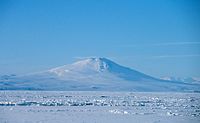
Photo from wikipedia
Abstract Substrate–atmosphere interfaces in Antarctic geothermal environments are hot–cold regions that constitute thin habitable niches for microorganisms with possible counterparts in ancient Mars. Cerro Caliente hill in Deception Island (active… Click to show full abstract
Abstract Substrate–atmosphere interfaces in Antarctic geothermal environments are hot–cold regions that constitute thin habitable niches for microorganisms with possible counterparts in ancient Mars. Cerro Caliente hill in Deception Island (active volcano in the South Shetland Islands) is affected by ascending hydrothermal fluids that form a band of warm substrates buffered by low air temperatures. We investigated the influence of temperature on the community structure and metabolism of three microbial mats collected along the geothermal band of Cerro Caliente registering 88°C, 8°C, and 2°C at the time of collection. High-throughput sequencing of small subunit ribosomal ribonucleic acid (SSU rRNA) genes and Life Detector Chip (LDChip) microarray immunoassays revealed different bacterial, archaeal, and eukaryotic composition in the three mats. The mat at 88°C showed the less diverse microbial community and a higher proportion of thermophiles (e.g., Thermales). In contrast, microbial communities in the mats at 2°C and 8°C showed relatively higher diversity and higher proportion of psychrophiles (e.g., Flavobacteriales). Despite this overall association, similar microbial structures at the phylum level (particularly the presence of Cyanobacteria) and certain hot- and cold-tolerant microorganisms were identified in the three mats. Daily thermal oscillations recorded in the substrate over the year (4.5–76°C) may explain the coexistence of microbial fingerprints with different thermal tolerances. Stable isotope composition also revealed metabolic differences among the microbial mats. Carbon isotopic ratios suggested the Calvin–Benson–Bassham cycle as the major pathway for carbon dioxide fixation in the mats at 2°C and 8°C, and the reductive tricarboxylic acid cycle and/or the 3-hydroxypropionate bicycle for the mat at 88°C, indicating different metabolisms as a function of the prevailing temperature of each mat. The comprehensive biomarker profile on the three microbial mats from Cerro Caliente contributes to unravel the diversity, composition, and metabolism in geothermal polar sites and highlights the relevance of geothermal-cold environments to create habitable niches with interest in other planetary environments.
Journal Title: Astrobiology
Year Published: 2019
Link to full text (if available)
Share on Social Media: Sign Up to like & get
recommendations!